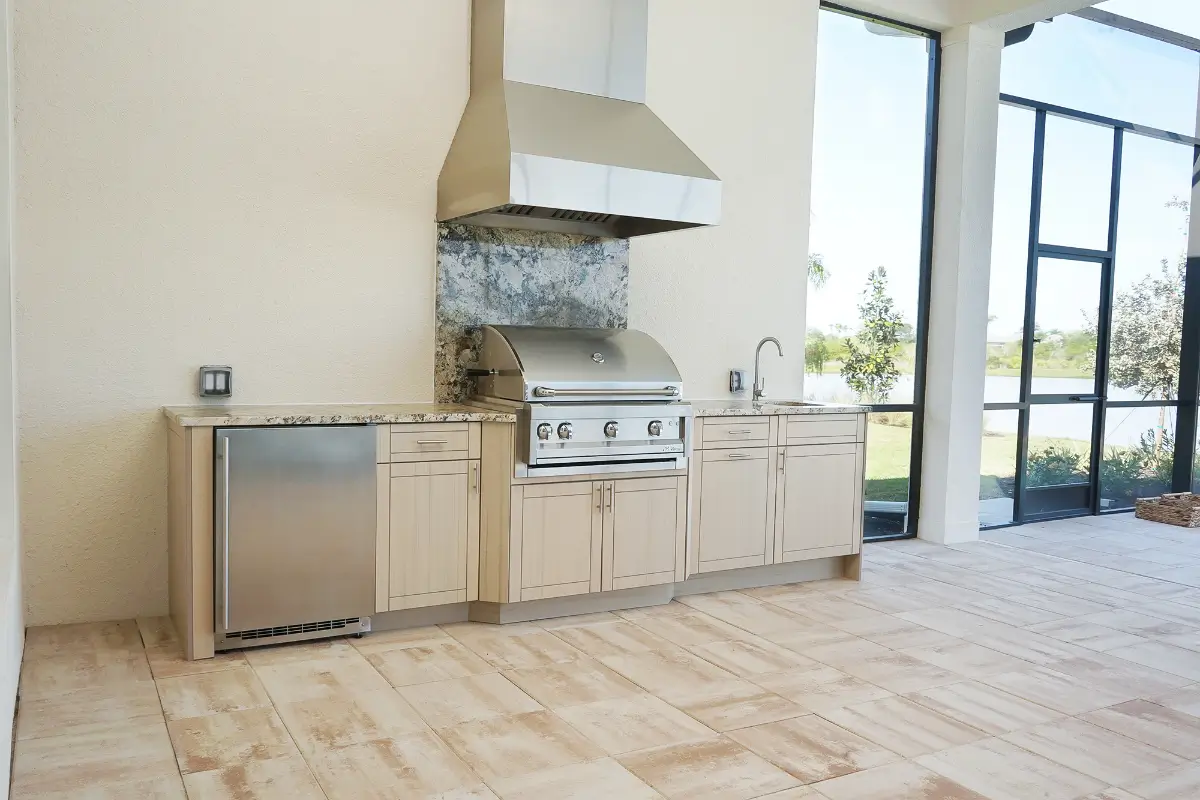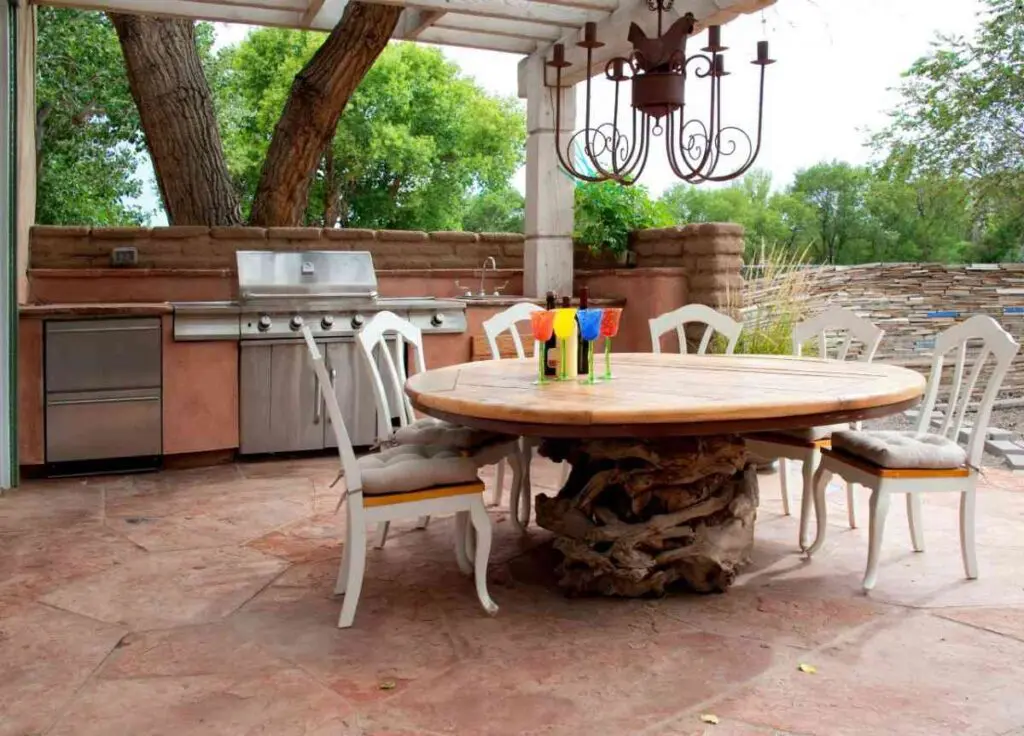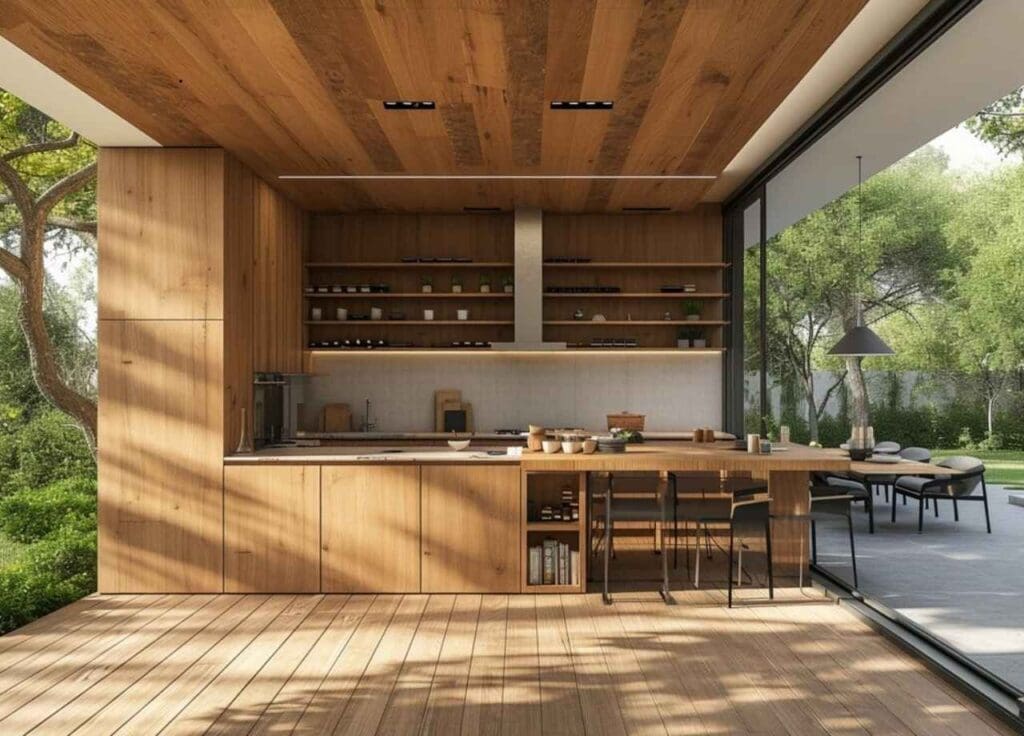
Florida Outdoor Kitchen Ideas That Actually Work in This Climate
Florida’s climate is a unique mix of sun, salt air, humidity, and seasonal rainstorms. Designing an outdoor kitchen that holds up in this environment while delivering the kind of experience homeowners want takes more than trendy ideas—it takes real planning, smart materials, and a layout that fits how people actually cook and entertain outdoors.
At Calico Outdoor, we specialize in building custom outdoor kitchens that not only handle Florida’s weather but also match the way our customers live. This post pulls from what we’ve learned over the years designing kitchens across the Jacksonville area and shows how to go beyond Pinterest boards into ideas that actually perform long-term.
Table of Contents
Start With the Layout That Matches How You Use the Space
The best Florida outdoor kitchens aren’t about squeezing every appliance possible into one build. They’re about shaping the space around how it will be used. That might mean a layout that prioritizes cooking efficiency, or one that creates an inviting atmosphere for hanging out while dinner is on the grill.
If your kitchen is near the house, a galley or L-shape layout may be all you need. It’s compact, leaves room for a dining area or lounge space, and allows for easy access to indoor plumbing and electric. For larger patios or poolside builds, a U-shape or G-shape layout creates more countertop space and naturally zones the area for prep, cooking, and serving.
Where you position your grill makes a big difference. Prevailing winds, afternoon sun, and proximity to doors or windows all factor in. You don’t want smoke blowing into the house or heat reflecting off the back wall of your home. Orientation matters as much as style.
Materials That Won’t Rot, Rust, or Fade
Florida is not kind to poor materials. Moisture, salt air, and high UV exposure wear out subpar finishes fast. That’s why high-quality outdoor-rated materials aren’t optional here—they’re the baseline.
We see a lot of homeowners asking for stainless steel, but not all stainless is equal. Marine-grade 304 stainless or powder-coated stainless frames last longer in Florida’s wet heat. Lower-grade stainless may start to pit or rust after a couple years, especially near the coast.
For cabinet cladding, stone and polymer-based finishes perform better than wood or MDF. These materials resist swelling, mold, and mildew. HDPE (high-density polyethylene) and PVC-based panels are increasingly popular for their durability and range of looks, including wood grain textures without the maintenance.

Countertops should be sealed and resistant to heat and UV. Natural stone looks great but needs the right treatment to survive Florida’s moisture swings. Porcelain and ultra-compact surfaces like Dekton are becoming go-to choices—they’re built to take the heat, rain, and direct sun without warping or discoloring.
Ventilation Isn’t Optional—It’s Essential
Many Florida outdoor kitchens are built under a covered patio, lanai, or pergola, especially to offer shade during the brutal afternoon sun. But covering the space doesn’t mean skipping proper ventilation.
Gas grills and side burners need to breathe. Without proper airflow, heat builds up, and smoke lingers. That not only makes cooking uncomfortable—it can damage the ceiling and leave greasy residue on surrounding surfaces.
Good ventilation includes gaps or vent panels at the base of cabinetry and strategic placement of chimney vents or vent hoods above the cooking area. If your kitchen is under a solid roof, a powered vent hood becomes a must. It pulls smoke and heat up and away from the space, keeping the area usable and safe.
Integrate Shelter From Sun and Rain
Afternoon rain showers are part of life in Florida, especially in the summer. If your kitchen doesn’t offer protection from rain, cooking gets cut short too often. And if there’s no shade, you’re battling heat while trying to grill dinner in August.
A permanent roof or pergola structure helps, but it’s the combination of overhead and side protection that really makes a Florida outdoor kitchen usable year-round. Power screens or retractable awnings give you flexibility. You can block sun and wind when you need to, then retract them for open-air cooking when conditions are perfect.
Think about how the space is used throughout the day. A west-facing patio may need more sun control in the afternoon. A kitchen near the pool might benefit from an extended canopy that creates a shaded lounge area next to the cook zone.
Think Beyond the Grill
Too many outdoor kitchens are little more than a grill, a side burner, and a counter. That setup gets old fast. A well-designed Florida outdoor kitchen becomes an actual extension of the home—built for hosting, relaxing, and cooking more than just burgers.
Consider integrating a sink and prep area to make the space functional for more than quick meals. A refrigerator or pull-out cooler keeps guests from heading inside for drinks. If you enjoy seafood boils, a power burner or wok station is a game-changer. Pizza ovens are also rising in popularity—especially wood-fired or gas-fired models that cook at high temps and deliver authentic results without needing a commercial setup.
If you like entertaining, a built-in ice maker or kegerator adds serious value. The goal is to keep everything you need within reach so the cook isn’t stuck running in and out of the house.
Keep the Design Cohesive With Your Home
An outdoor kitchen shouldn’t feel like a bolt-on project. It should match the architecture and finish of your home, or at least complement it. That means using colors, textures, and shapes that create visual flow from inside to out.
If your home leans modern, matte finishes, clean lines, and monochromatic tones work well. For coastal homes, lighter colors, stainless hardware, and driftwood-toned panels feel more natural. Brick homes often look better with stone or stucco textures that mirror existing exterior elements.
Lighting plays a huge role in how your kitchen feels once the sun goes down. Use layered lighting—a mix of task lights over the grill, ambient under-cabinet lighting, and decorative fixtures—to bring warmth and visibility to the space. Solar or low-voltage options cut energy costs and simplify installation.
Build for Hurricane Season, Not Just Sunshine
A lot of Florida kitchens look great—until the first big storm rolls through. Wind, flying debris, and heavy rainfall can damage outdoor kitchens that aren’t anchored or weatherproofed correctly.
Permanent outdoor kitchens need proper drainage, wind-rated construction, and appliances secured to frames. Cabinet doors and drawers should be gasketed or sealed to prevent water intrusion. Covers aren’t enough when winds hit 50+ mph.

Appliances should be rated for outdoor use, not just “weather resistant.” That includes gas connections, hinges, and electronics. Consider hurricane straps or ground anchors for freestanding structures. And if you’re near the coast, salt-rated hardware is a must.
Plan for the Seasons—Yes, Even in Florida
Florida may not have winter in the traditional sense, but seasonal use patterns still affect how your kitchen is used. In summer, heat and storms push more people to cook early in the day or late in the evening. Spring and fall tend to be prime months for entertaining. Planning your layout and features around those patterns makes the kitchen more usable year-round.
Outdoor heaters, fire bowls, or fire tables extend the use of the space on chilly nights. Ceiling fans or misting systems help during peak summer. Zoned lighting helps control brightness levels depending on the occasion—bright for cooking, dim for hanging out.
Smart controls are worth considering if you’re building new. Wi-Fi enabled lighting, audio systems, or grill controllers give you more flexibility and can be controlled by app or voice. Just make sure all wiring and components are outdoor-rated.
The Right Ideas Are the Ones That Get Used
Trendy design elements are easy to throw into a mood board. But the best outdoor kitchens come from knowing how real people live, cook, and entertain in Florida. If you’re designing your own space, ask yourself: Will I still be using this setup three years from now, or will it be sitting unused because it’s too hot, too exposed, or too hard to clean?
Good ideas aren’t just about what looks impressive—they’re about what works. A Florida outdoor kitchen should stand up to the climate, match your lifestyle, and feel like a natural part of your home.
Need help building something that actually works in Jacksonville’s heat, salt, and storms? Calico Outdoor designs and installs custom outdoor kitchens that perform year after year.
